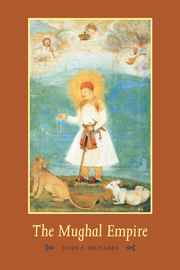Book contents
- Frontmatter
- Contents
- List of maps and tables
- General editor's preface
- Preface
- Introduction
- 1 Conquest and stability
- 2 The new empire
- 3 Autocratic centralism
- 4 Land revenue and rural society
- 5 Jahangir 1605–1627
- 6 Shah Jahan 1628–1658
- 7 The War of Succession
- 8 Imperial expansion under Aurangzeb 1658–1689
- 9 The economy, societal change, and international trade
- 10 Maratha insurgency and Mughal conquest in the Deccan
- 11 The Deccan Wars
- 12 Imperial decline and collapse, 1707–1720
- Conclusion
- Glossary
- Bibliographic essay
- Index
- THE NEW CAMBRIDGE HISTORY OF INDIA
5 - Jahangir 1605–1627
Published online by Cambridge University Press: 28 March 2012
- Frontmatter
- Contents
- List of maps and tables
- General editor's preface
- Preface
- Introduction
- 1 Conquest and stability
- 2 The new empire
- 3 Autocratic centralism
- 4 Land revenue and rural society
- 5 Jahangir 1605–1627
- 6 Shah Jahan 1628–1658
- 7 The War of Succession
- 8 Imperial expansion under Aurangzeb 1658–1689
- 9 The economy, societal change, and international trade
- 10 Maratha insurgency and Mughal conquest in the Deccan
- 11 The Deccan Wars
- 12 Imperial decline and collapse, 1707–1720
- Conclusion
- Glossary
- Bibliographic essay
- Index
- THE NEW CAMBRIDGE HISTORY OF INDIA
Summary
As Akbar lay ill and dying in 1605, Jahangir, then Prince Salim, nearly lost the throne to Khusrau, his seventeen-year-old eldest son. Raja Man Singh Kachhwaha of Amber and Mirza Aziz Koka (whose daughter was married to the young prince) failed to persuade a majority of the nobles to support this coup. Instead, an opposition party, led by the Sayyids of Baraha, brought Salim safely to the dying emperor, who, before he succumbed, invested the heir with a turban, robes, and Akbar's own dagger. After a week of mourning, Salim mounted the throne in Agra fort, placed the throne on his own head, and took the title Nur-ud-din Jahangir Padshah Ghazi. A confrontation had occurred, but not a war for the succession.
Apparently reconciled to the new regime, Man Singh went to Bengal as the governor, while Khusrau, seemingly restored to favor, resided under semi-confinement at Agra fort. Six months later in April, 1606, Khusrau, on the pretext of visiting Akbar's tomb, fled toward the Punjab with several hundred followers. Quickly assembling an army of 12,000 (paid for from 100,000 rupees seized from an imperial treasure caravan), Khusrau besieged the governor of the Punjab at Lahore. Jahangir, attempted negotiations with his son failing, sent a relief army which engaged the prince outside the city. The short, bloody, battle ended in a rout. Khusrau tried to flee toward Kabul, but the whole countryside was alerted for him through the network of pargana headmen and city provosts.
- Type
- Chapter
- Information
- The Mughal Empire , pp. 94 - 118Publisher: Cambridge University PressPrint publication year: 1993

